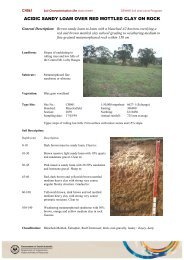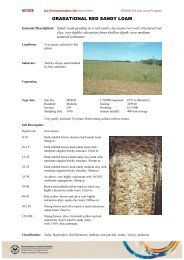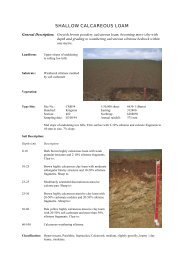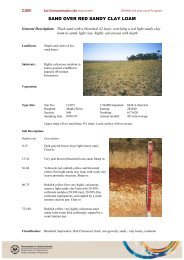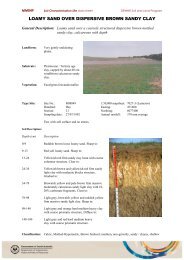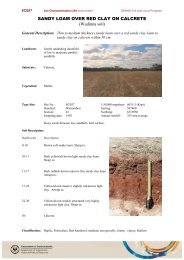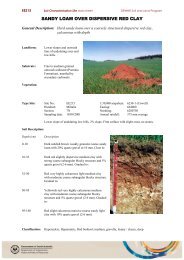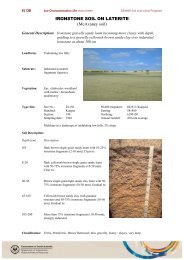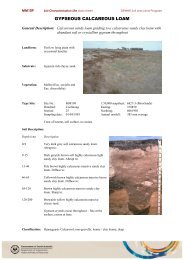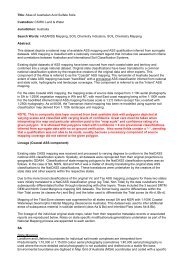Create successful ePaper yourself
Turn your PDF publications into a flip-book with our unique Google optimized e-Paper software.
• Continuous variables that are not normally distributed are transformed to an approximately normaldistribution and uncertainties are then estimated. Hydraulic conductivity and electrical conductivityare assumed to be distributed log-normally, unless there is evidence to the contrary. The mean isrecorded in untransformed units to improve the ease of interpretation but the standard deviation isrecorded as a transformed value. For example, the hydraulic conductivity may be estimated to be100 mm/hr with a standard deviation of 0.5 log(mm/hr). The range of ± 1 standard deviation (i.e.68% of the population) around the mean of 100 mm/hr would therefore be 32–320 mm/hr. Theadvantage of recording the transformed standard deviation is that that only one value is needed torepresent dispersion of the asymmetric distribution.• Variables with fixed ranges (e.g. percentage coarse fragments) or coarse stepped scales aremodeled with triangular probability distributions unless there is evidence to the contrary. Thetriangular probability distribution is assumed to be symmetric. The mean is estimated anddispersion is defined as (95% quantile – 5% quantile)/2. The distribution between the minimumvalue and the 5% quantile, and between the 95% quantile and the maximum, is assumed to be flat.The distribution is shown in Figure 3.• Uncertainties for nominal variables are represented by the probability that a class is correct (e.g.the uncertainty that a landform element type is a beach ridge is 0.8). Combined uncertainties arecalculated by multiplying component probabilities.Every soil attribute has an estimated uncertainty with two components.• The first component (u1) is associated with the measurement error for the given attribute at theprofile or site – it will be significantly reduced if replicated sampling or bulking has beenundertaken. If the attribute (e.g. water retention at –10 kPa) is being estimated using apedotransfer function, then the uncertainty includes both the measurement error of theexplanatory variables (e.g. texture, structure, and bulk density) and error due to model underlyingthe pedotransfer function.• The second component (u2) of uncertainty is due to spatial variability within the land-unit tract atthe lowest level in the hierarchy for which data are available.In most parts of Australia, there is limited information on both of these sources of uncertainty and it willrequire good judgment to provide estimates. However, the alternative of providing estimates of meanvalues without information on variability is potentially misleading.In the absence of better information, we will use default values of uncertainty drawn from the publishedliterature on spatial variation and our general knowledge (Table 4). The default values are conservative (i.e.most likely on the high side) and intended to encourage more attention to the estimation of uncertainty.The component of uncertainty due to measurement (u 1 ) can be determined using the estimation methodfor each variable as a guide (e.g. Table 25 for bulk density). The component of uncertainty due to spatialvariability (u 2 ) can be determined using several lines of evidence including:• cartographic scale of the survey and intensity of sampling (this is expressed via the Order of Survey(Table 9, Soil Survey Staff 1993))• qualitative assessment of landscape complexity.16




